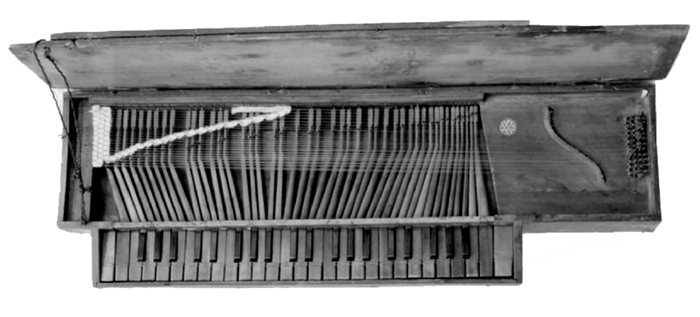
Clavichords in Britain No. 11
THE ANONYMOUS TRIPLE-FRETTED CLAVICHORD
IN THE RODGER MIRREY COLLECTION
Darryl Martin, Edinburgh

The Anonymous triple-fretted clavichord which is part of the Rodger Mirrey Collection, now at the University of Edinburgh, is one of the best known of the early clavichords. It is thought to date from about 1620. Although the instrument itself is unassuming in looks, it is generally accepted to be one of the finest-sounding instruments of its type. It was one of the first antique fretted clavichords of which modern ‘copies’ were made, examples of which date from the 1970s. Although there was no published drawing of the instrument at the time, Dr Mirrey kindly gave access to instruments from his collection to those who were particularly interested in early keyboards. He acquired the instrument in 1966 from Robert Henshaw of Bradford on Avon, who had it from Messrs Legge of Cirencester; they acquired it from a Mr Underwood. Nothing is known of its previous history.
The case is made of a rather soft wood (probably poplar), with a soundboard of coniferous wood. The bridge is curved and glued to the soundboard, and there is a small rose to its left. The keyboard protrudes from the front of the instrument, a feature which has been partly responsible for the suggestion that it is an early instrument, resembling (as it does) the gemein clavichord illustrated by Michael Praetorius in Part 2 of Syntagma Musicum, published in 1619.
The instrument certainly does have a similar basic appearance, and has a number of features which lead one to believe it is indeed an early instrument. Quite aside from the protruding clavichord, it has a thin board under the keys, in a similar position to where the low soundboard of the very earliest clavichords would have been. The strings are all hitched to a rail glued to the left case side, rather than having the treble strings attached to a rail (part of which would form the rack) glued along the inside of the spine.
The compass is that typically found on early instruments: C/E (short octave) to c³ (45 notes), and the clavichord is double-strung throughout. It is triple fretted, generally as one would find in the majority of clavichords of this type, but (rather unusually) g# in the tenor has a pair of strings entirely to itself. This can only be (as, I believe, John Barnes first suggested) to allow the note to be tuned to either g# or a♭ as required by the music (it would be possible – if difficult – to bend tangents higher in the compass should other A♭ s be required).
The carving of the keylevers is unusual. Normally it is the angled section of the lever, just behind the balance point, that is given a decorative carving; here it is the back part, bearing the tangents, that is carved in an inverted V shape. This can be clearly seen in this plan-view photo.

Although the instrument has often been presumed to be German like the vast majority of other surviving Northern-European clavichords, it is probable that it is, in fact, of Flemish origin. A number of things suggest that this may be the case. The keyboard is projecting, as described above, but unlike the Praetorius illustration the bottom of the keywell is just below the keys, rather than at the bottom of the case. This is also found in earlier images of Flemish clavichords (dating from c. 1500 – c. 1600). The poplar case is similar to the Flemish harpsichords of the period, and the baseboard is slightly raised – a feature also found in the earlier Flemish illustrations. The scribed lines on the keyboard are very similar to those found on original Flemish keyboards, albeit with different key-covering materials.
Perhaps the most telling features to suggest a Flemish origin are several which are no longer present on the instrument. The ends of the lid were originally covered with cross-grained battens which extended above and below the lid (most German instruments have battens which only extend below). The battens are now entirely missing, but there are small traces of wood slivers from where the battens were removed uncleanly. The other feature is that the instrument was, almost certainly originally, covered with paper. Although there are some obvious papers on the instrument at the moment (most clearly seen on the nameboard), these are almost (if not entirely) of a more recent date, but there are small traces which are visible on various parts of the interior and exterior of the case and lid. These pieces are so small so as to suggest the finish was deliberately removed at an early period of the instrument’s history, and there is no way of determining what (if any) design was on the instrument.
The instrument was in good playing condition when it arrived in Edinburgh, and is one of the most enjoyable clavichords in the collection to both play and listen to, having a sound surprisingly different from that of the other (later) anonymous triple-fretted clavichord at Edinburgh, which was part of Raymond Russell’s collection.
This article by Darryl Martin in the series ‘Clavichords in Britain’ appeared in BCS Newsletter 35, issued in June 2006. At present, the clavichord described here is not on display while St Cecilia’s Hall is being rebuilt. It is likely to be again on display when the hall re-opens later in 2017.
updated February 2017